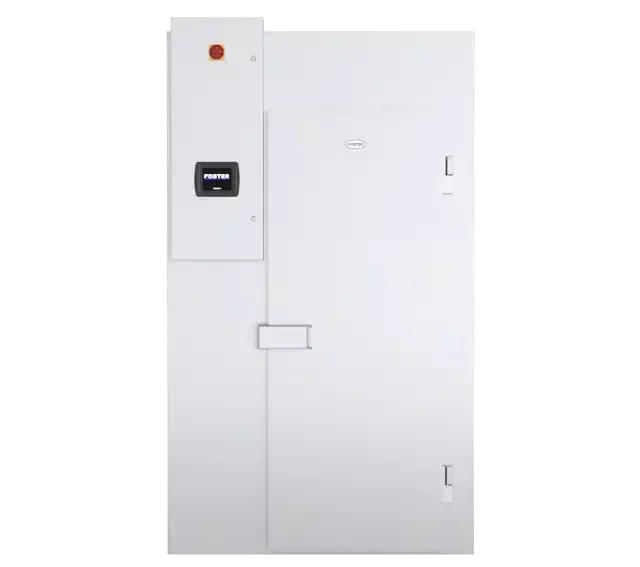Foster Reach In Blast Chillers and Freezers
As the first company to introduce blast chilling to the industry, Foster offers a superb range of commercial reach in blast chillers and freezers, including their blast chillers and occasional freezers range. These are specially designed with a tray loading feature to utilise storage space and guarantee food safety. By swiftly reducing the temperature of food, our blast chillers and shock freezers ensure cooked food retains its quality.

An Innovative Selection of Blast Chilling Options
The innovative range of Foster commercial reach in blast chillers and freezers features a host of design features and benefits that allow caterers to chill food efficiently and safely, time and time again.
From the Touchpad Cabinet models to the economic XTRA and Controlled Thaw Cabinets, Foster always integrates food safety into our equipment design.
Find the Right Reach In Blast Chiller for Your Project
No matter what the size of your project is, we have a range of premium large-capacity modular reach in blast chillers and blast freezers designed to cope with the most demanding, high-volume commercial kitchens. We can guide you to find the best model to suit your requirements.
What is blast chilling?
Department of Health Guidelines state that to safely Blast Chill food its temperature must be reduced from +70ºC to +3ºC or below within 90 minutes. The Foster range of reach in blast chillers exceeds this requirement and can safely blast chill food within 90 minutes even from a starting temperature of +90ºC.
What is blast freezing?
The Blast Freeze process requires that food be reduced from a temperature of +70ºC to –18ºC in no more than 240 minutes, ensuring food remains safe for consumption while maintaining its quality.
Basic principles of blast freezers and chillers
Current food legislation requires that all food must be cooled as quickly as possible. This means that whenever food is chilled or frozen, it must be in the “Danger Zone” between +8ºC and +68ºC, where bacteria multiply fastest, for as little time as possible. To achieve this, a specially designed reach in Blast Chiller or Blast Freezer is required, as standard refrigeration equipment just isn’t capable of providing chilling at that speed or intensity.
Why blast chilling and freezing technologies are important
What is the ‘danger zone’? What are the Department of Health Guidelines? These are the types of questions that as a caterer you should know the answers to. However, blast chilling and freezing is not as straightforward as standard reach-in refrigeration as there is a process to handling food safely. The Foster range of reach in blast chillers, freezers and thaw guide contains everything you need to know about safely blast chilling and freezing. The handy guide, along with ‘Ice Handling’ advice and a food safety training guide can all be found in our dedicated food safety section. We offer support in the purchase and use of blast chilling equipment and our team is on-hand to help you identify the type of equipment you need as well as offering on-site training for your team. View our range of blast chillers and freezers or contact us for more information.
The Safe Way to Blast Chill, Freeze and Thaw (PDF)FAQS
Regethermic introduced blast chiller technology to Australia. Blast freezers can reach temperatures as low as -40°C or lower, rapidly freezing food to preserve quality. HACCP.
Regethermic introduced blast chiller technology to Australia. Blast freezers work by using powerful fans and extremely low temperatures to quickly freeze food, reducing ice crystal formation and preserving freshness. HACCP.
It varies but freezing using a blast freezer can take anywhere from 30 minutes to a few hours depending on the quantity and type of food. Give us a call at Regethermic to find out your specific needs.
A blast freezer is an industrial freezer designed for rapid freezing, often used to preserve food quality and safety. Vital for HACCP. The blast freezer technology was introduced to Australia by Regethermic, meaning that we’ve been in the industry for quite some time.
To use a blast freezer effectively, all you need to do is load food items onto trays or racks, set the desired freezing temperature and time, and monitor the process to ensure proper freezing. HACCP.
Blast freezers are primarily used in industries that require rapid and efficient freezing of food and other perishable products to preserve their quality and safety. The industries and sectors that commonly use blast freezers include:
- Food Processing and Manufacturing: Blast freezers are extensively used in food processing facilities to quickly freeze products like fruits, vegetables, meats, seafood, baked goods, and prepared meals. This ensures that the food maintains its taste, texture, and nutritional value.
- Restaurants and Catering: Commercial kitchens in restaurants and catering businesses may use blast freezers to chill or freeze large quantities of food quickly, allowing for better food preparation and storage.
- Hospitality and Airlines: The hospitality industry, including hotels and airlines, may use blast freezers to prepare and store large quantities of pre-cooked or pre-frozen meals for their guests.
- Bakeries: Bakeries use blast freezers to flash-freeze baked goods such as bread, pastries, and cakes to maintain their freshness and extend shelf life.
- Ice Cream Production: Blast freezers are essential in the production of ice cream and other frozen desserts to achieve the desired texture and prevent ice crystal formation.
- Seafood and Meat Processing: The seafood and meat industries rely on blast freezers to freeze and store products like fish, shrimp, poultry, and red meat, preserving their quality and reducing the risk of spoilage.
- Dairy Industry: Dairy manufacturers use blast freezers for products like cheese, butter, and yogurt to maintain product quality and safety.
